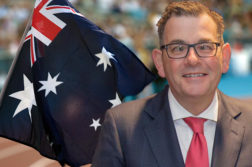After a media firestorm, and its accompanying public disapproval, we've now got a reaction from the Government. Speaking on Sunday afternoon, Prime Minister Julia Gillard and Communications Minister Stephen Conroy have banned the “spruiking” of live odds during sports broadcasts.
The issue has burst to prominence in recent months, in large part due to ubiquitous Sydney bookmaker Tom Waterhouse, whose unctuous visage seems to be on every television screen in the country.
Sports betting has ramped up in recent years, with the aggressive entry of big wagering companies like Tabcorp and Betfair into the Australian sports betting market – accompanied, of course, by high-profile advertising campaigns targeted squarely at young men. Some of the most notorious, created by the hipsters at Droga5, openly parody the compulsive nature of mobile phone sports betting with a series of ads playing on the idea of finger-poking.
Online and mobile phone sports betting has exploded in the past six years, albeit from a small base. Sports betting accounted for approximately $350 million in 2010, on the latest figures we have available. This is small coin compared to the $10.2 billion that poker machines drain from Australian pockets.
But the habit is growing fast. A recent study by Southern Cross University found that half of those who wager online had started since 2006. Southern Cross University's Sally Gainsbury told The Conversation's Justin Norrie that “internet gambling poses unique risks to players; it is constantly available and people can play online in private with relative anonymity".
"There is evidence that there are higher problem gambling rates among people who gamble online, and these internet gamblers are more likely to gamble in a greater number of activities, and also more frequently engage in gambling," Gainsbury told the ABC's Simon Santow in another interview.
There's no doubt that advertising is one factor in online sports betting's growth. As well as Tom Waterhouse turning up in football commentary panels, teams also wear gambling branding on their shirts, and sports betting promotion is unmissable on television and at the grounds themselves. Penrith's NRL ground is even called Centrebet Stadium. As Monash University's Charles Livingstone recently pointed out, “sports betting is in your face, on TV, at the ground and in the sports pages of newspapers”.
“More importantly, it’s in the faces of your children, on footy tipping websites, on the uniforms of their heroes, and endlessly promoted during coverage of their favourite games,” Livingstone added. According to Monash University's Samantha Thomas, children watching an AFL game on television are exposed to an average of 50 separate episodes of sports gambling advertising. Kids taken to a ground are even more exposed: Thomas and her research team estimated that during a visit to an AFL stadium to watch a match, children would see 341 minutes of gambling advertising.
Anti-gambling advocates have been dismayed. South Australian independent Senator Nick Xenophon has a long history fighting the scourge of poker machines, and has been active in encouraging a legislative ban on sports betting advertising. “The public is sick and tired of having offers to punt shoved down their throats,” he said last week.
“But just like the Prime Minister's backflip on meaningful poker machine reform, Minister Conroy has proven that this Government cannot be trusted to put the interests of ordinary Australians above those of the multi-billion dollar gambling lobby.”
Community anxiety about the issue appears to be strongest in Xenophon's home state, where the South Australian government has already tried to move forward with state legislation on the issue. The South Australian Labor government of Jay Weatherill has tabled legislation to ban the advertising of live odds during sports broadcasts – although how he would do so, given the federal nature of broadcasting laws, remains unclear. “AFL football is one of the top three television programs watched by children under 14 years old and the normalisation of sports betting has the strong possibility of creating gambling patterns in young people who follow a sport,” Weatherill said last Monday.
So with the pressure building, on Sunday the Government decided to act. “From the moment that the players step onto the field to the moment that they leave the field, there will be no live odds,” Julia Gillard declared in a doorstop interview with Conroy.
“This is good news for families, because families I think have become increasingly frustrated about the penetration of live odds into sporting coverage, and worried that their young son or daughter is now talking about the game not through the prism of what’s happening on the field, but through the prism of the associated betting.”
Going by Gillard's rhetoric, you'd think that all gambling advertising had been peremptorily banned. That's not the case.
The Government's measures are half-hearted at best, prohibiting only the promotion of odds during live commentary. All sorts of other advertising, including of course the slick television commercials, will still be allowed, for instance during half-time breaks in play. Most critically, as New South Wales Gaming Minister George Souris observes, sports betting advertising will still be allowed before games start, which is obviously the most lucrative time for bookmakers and wagering companies.
Nick Xenophon agrees, telling reporters this week that “for the Prime Minister to announce victory yesterday is a bit like a player walking off at halftime during a game and saying that they have already won”.
On Lateline last night, Conroy was defending the government's move, claiming that it was indeed a tough measure. “We're actually banning live odds and gambling ads during play after – after – 8.30 and 9,” he told the ABC's Emma Alberici. But straight away, the Communications Minister contradicted himself, alluding to the commercial pressure from broadcasters, who desperately need the advertising revenue to pay for their expensive sports programming: “We've also got to look at it from the perspective of companies [who]are bidding increased amounts of money to buy the live sport, and we want to ensure that those key iconic matches stay on free-to-air television.”
You can't be much clearer than that: Conroy has caved in to the interests of the big broadcasters like the Nine Network, which have serious money troubles and can ill-afford to say goodbye to the millions Tom Waterhouse is throwing their way.
The ABC's respected sports commentator Gerard Whateley summed up the faux-compromise in a discussion with Jonathan Green last night. “If this was the least the government could do, then it has done the least the government could do,” he said. “I'll also say this, the gambling agencies are waiting to be restricted … they're laughing their backsides off that nobody has stepped in yet.”
“They are the kids in the lolly shop that have gone mad and are waiting to be told to stop, and where the restrictions are, and I don't even think you'll hear an outcry.”
And indeed the industry has made very little noise about the current proposal. The contrast with the muscular anti-government campaign mounted by the clubs lobby over poker machine reform is instructive.
What that tells you is that, unlike the poker machine reforms, the gambling industry doesn't think these new restrictions will have much impact on its revenues. Indeed, these latest restrictions could even be viewed as a handy fig-leaf for an industry that knows it is less than popular with ordinary Australians. The serious lobbying will go on behind closed doors, unless and until real money is at stake. As the clubs campaign against the government showed, the gambling industry has plenty of influence over elected governments, and is none too shy to use it.
So is this a win for anti-gambling campaigners? No, it's another win for the gambling industry.
Donate To New Matilda
New Matilda is a small, independent media outlet. We survive through reader contributions, and never losing a lawsuit. If you got something from this article, giving something back helps us to continue speaking truth to power. Every little bit counts.



